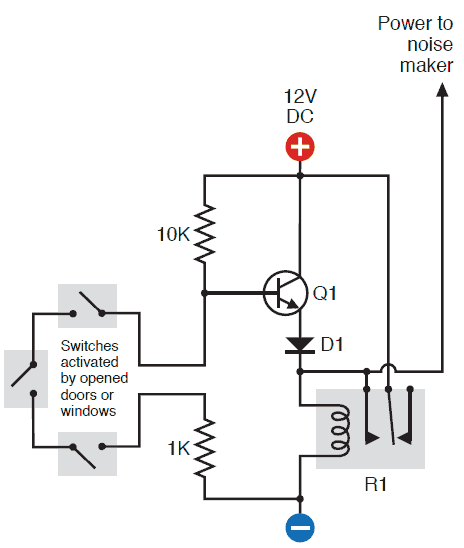
magnetic switch activated alarm

A circuit was assembled on a breadboard, which is divided into two sections. The right section is dedicated to generating a wailing alarm, while the left section is...
The circuit design comprises two main functional blocks: the alarm generation circuit and the control or input section. The right section, responsible for the alarm, typically includes a sound-generating component, such as a piezoelectric buzzer or a small speaker. This component can be activated by a signal from the left section, which may include switches, sensors, or other input devices.
The left section may incorporate a simple control mechanism, such as a push button or a motion sensor, which triggers the alarm when a specific condition is met. For instance, if a motion sensor detects movement, it sends a signal to the alarm circuit, causing the buzzer to emit a loud sound.
Power supply considerations are essential for both sections. A suitable voltage regulator may be implemented to ensure that the components operate within their specified voltage ranges. Additionally, decoupling capacitors can be used to filter out noise from the power supply, ensuring stable operation of the circuit.
The interconnection between the two sections can be achieved using jumper wires on the breadboard, allowing for flexibility in the circuit layout. Proper labeling and organization of components on the breadboard will facilitate troubleshooting and modifications.
Overall, this circuit can serve various applications, such as security systems, alert mechanisms, or educational projects, demonstrating fundamental principles of electronics and circuit design.Hello, I assembled a circuit on a breadboard which is separated in 2 parts: the right part is for generating an alarm which wails. the left part is.. 🔗 External reference
The circuit design comprises two main functional blocks: the alarm generation circuit and the control or input section. The right section, responsible for the alarm, typically includes a sound-generating component, such as a piezoelectric buzzer or a small speaker. This component can be activated by a signal from the left section, which may include switches, sensors, or other input devices.
The left section may incorporate a simple control mechanism, such as a push button or a motion sensor, which triggers the alarm when a specific condition is met. For instance, if a motion sensor detects movement, it sends a signal to the alarm circuit, causing the buzzer to emit a loud sound.
Power supply considerations are essential for both sections. A suitable voltage regulator may be implemented to ensure that the components operate within their specified voltage ranges. Additionally, decoupling capacitors can be used to filter out noise from the power supply, ensuring stable operation of the circuit.
The interconnection between the two sections can be achieved using jumper wires on the breadboard, allowing for flexibility in the circuit layout. Proper labeling and organization of components on the breadboard will facilitate troubleshooting and modifications.
Overall, this circuit can serve various applications, such as security systems, alert mechanisms, or educational projects, demonstrating fundamental principles of electronics and circuit design.Hello, I assembled a circuit on a breadboard which is separated in 2 parts: the right part is for generating an alarm which wails. the left part is.. 🔗 External reference





